After enormous difficulty in campaigning for sexual and gender minority (SGM) rights in Nepal for about 7 years or so since we founded Blue Diamond Society in 2001, in 2007 Nepal’s interim governments’ announcement of holding a New Constituent Assembly election changed the way we perceived sexual and gender minority (SGM) rights campaign. We didn’t waste time to explore finding new ground to mainstream sexual and gender minority (SGM) rights and campaigns. We landed ourselves into Nepal’s political sphere which was traditionally held by either dynastic family members or long term party cadres essentially starting with their established sister/brother wings like student unions, trade unions or women wings.
Engagement with political parties for Nepal’s first Constituent
Constituent-Assembly elections
Before the dates for the 2008 Constituent Assembly elections were finalized, we decided to capitalize on the moment by mobilizing and actively reaching out to the different parties. Soon, the sexual and gender minority (SGM) community began to be seen as a significant vote bank. We urged different parties to include SGM rights in their respective party manifestos, if they cared to win our votes. Once our cause was taken up as a public mandate, and we began to envision ourselves as an empowered voting bloc, able to make a difference in the electoral process, the distinction between personal and the political realms began to dissolve. This complicated the question of public and private life, especially given the context of our activism We were going public, and the visibility of our movement was growing, but at the same time we were demanding that sexuality was a private matter and hence state interference was unacceptable. Some people found this confusing but we clarified the two difference aspect of our lives — that we were able to live and participate in public life, and at the same time, our choice of who to love and how to self-identify must remain a private matter. In engaging with political parties and the election commission around the first CA elections, I was able to collaborate with Mr Bhojraj Pokhrel, who was the election commission chief at the time. I knew him since he was working for USAID on HIV/AIDS in Nepal in 2004–06. I lobbied with him to reinvigorate the question of visibility of queer lives. In particular, we asked him to be more proactive in ensuring that political parties were aware of the legal protections against SGM persons, and ensured he was informed over challenges for SGM persons to vote. This was critical for the success of our movement as, in South Asia, making personal connections within the political realm and wisely using them to solve problems effectively, which may not be solved with loud protests in the street, is an essential strategy.
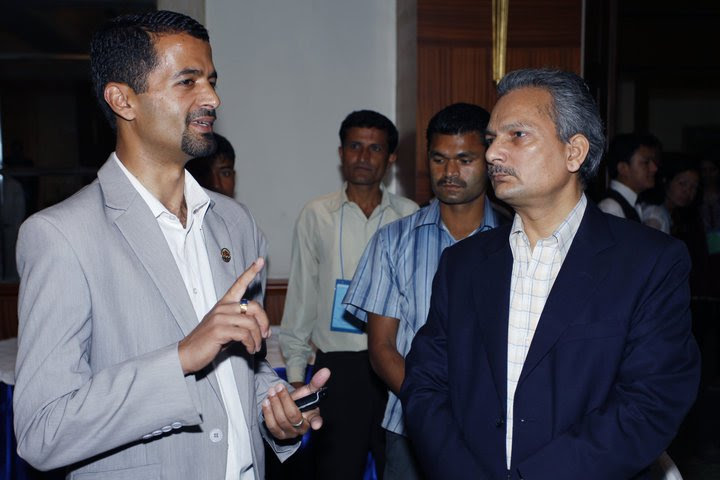
Sunil Babu Pant with Dr Baburam Bhattarai, former PM of Nepal and also the first finance minister who allocated budget for LGBTI for the first time in national budget in 2008
The Maoist, who had led the people’s movement against the monarchy from 1996–2006, were registered as a political party since the 2006 Comprehensive Peace Agreement. The Maoists were the first to include sexual and gender minorities in their manifesto. At the time, they were looking for the broadest possible support possible and so were very approachable, and the shared connection with Dr. Bhattarai also helped with access. Soon other parties such as the Nepali Congress (NC) and the United Marxists and Leninists (UML) followed. This is not an uncommon trend. While there is a prevalent (and perhaps rightful) mistrust of the Maoist agenda in Nepal, especially as to how genuinely committed to the constitution-writing and democratization processes they are, on the question of marginalized and minority rights and issues they have always been far more progressive than other parties in Nepal. This progressive leadership has encouraged other parties to be more inclusive as well.
Following our lobbying activities and engagement with political parties, my involvement with politics unexpectedly went a step further. On the last day of filing nominations, I had a surprise call from the Communist Party of Nepal (United), a small communist party. The President of the Communist Party of Nepal (United) was interested in BDS’ activities and wanted someone from BDS to be a candidate for the proportional representation (PR) race in the Constituent Assembly elections, and so I decided to put forward my candidacy. The party president wanted to get the candidacy endorsed by the central party committee within a span of 1–2 hours so I did not have much time to make what I realized was a difficult choice about my political participation. I never thought I would be a politician in my life. In fact I never liked politics, particularly as they are practiced in Nepal, I was happy doing human rights work, being a member of civil society. After discussions with the Blue Diamond Society staff, however, we decided to move ahead and further our political involvement without harboring any expectations. Having realized the importance of being part of the broader movement for democracy in Nepal, we believed that my candidacy and SGM involvement in mainstream politics would send a good message that, as a community, we were actively supporting the constitution-building process.
We decided to campaign in the districts where the Party did not already have strong support. Our campaign was a great source of interest for both the Nepali and the international media, as it provided an unusual spectacle — party workers carrying the rainbow flag in one hand and the communist flag in the other! We mobilized Blue Diamond Society offices at the district level 5 to garner votes.
In terms of electoral process, Nepal follows a unique combination of the first past the post and proportional representation. Since the CPN (United) was a small party, the past trends suggested that even if the party received one seat, it would be a success. Once BDS joined forces with CPN (United), though, there was a noted rise in indications for the Party’s potential share of votes; at one point, the predictions reached as high as 155,000 votes. In the end, although CPN (United) received a significant number of votes, the party did not secure any seats in the FPTP race but did win 5 seats in the proportional representation race. Once seats are won in the PR race, the Party has to go through its list of PR candidates (previously submitted to the Election Commission) and approve the names of its choice MPs. CPN (United) did this by assessing those districts where the most votes were cast in favour of the party. It was found that the 15 districts in which BDS activists had campaigned and networked yielded the most favorable results. Through our capacity for organization and mobilization, and the fact we had local presences in so many districts, it was undoubtedly the BDS vote which carried the campaign. In recognition of this, I was chosen as one of the Party’s representatives and became a CA Member. I also was amused to find-out that CPN (United) party was so inclusive and pro-minority communities.
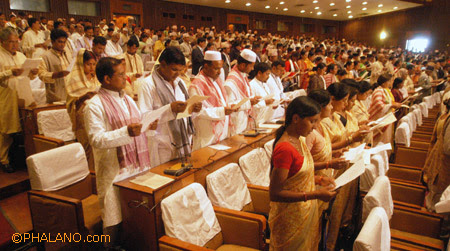
Swearing in ceremony on first day of CA
The above explains how I came to be elected in Nepal’s first Constituent Assembly (2008–12) and how I began my campaign to contribute to the historic task of writing a new constitution for the Federal Democratic Republic of Nepal. Below I will discuss my participation in the Constituent Assembly and Nepal’s historic constitution-writing process.
Participation in Nepal’s Constituent Assembly 1 (2008–2012)
It was only once I was in the Constituent Assembly that I realized how effective and influential it is to be inside the halls of power. In 2008, in a meeting with the first Prime Minister, Prachanda, and the first finance minister, Dr Baburam Bhattrai (Dr Bhattarai is the intellectual leader of Maoist party and comes from the same district as me, Gorkha), Dr. Bhattarai agreed to allocate a small budget for sexual and gender minorities from the state budget. This was a historic moment for us. Since then, the national budget for SGM programs grew incrementally every year throughout the first constituent assembly. Although this may be seen as a tokenistic form of support, it has had a huge impact in terms of expressing state endorsement of our legitimacy as a population. In 2011, twenty-five out of seventy-five districts, of their own accord, contributed towards this budget, while also introducing their own development programs targeting SGM communities.
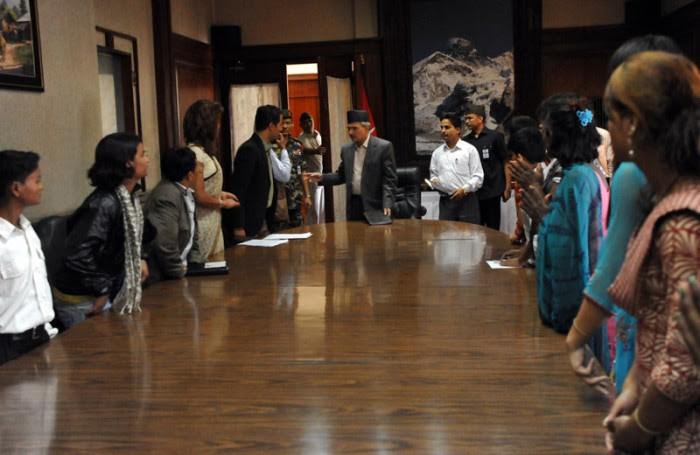
A delegation to the PM of Nepal in 2012 demanding to speed up implementing supreme court’s 2007 order
In addition to meeting with the political elite, after joining the CA-1, I started a campaign organizing young CA members against the traditional ways the older generation of leaders are thinking about and guiding the nation. The National Democratic Institute (NDI) provided support for our meetings. The group of young CA members ran an interaction program, inviting the top leaders of major parties to determine the ways and a timeline for reaching a solution on political deadlock around key constitutional issues. Our activities were informal but the senior leaders started listening and counting young leaders to some extent in policy and decision-making processes within the Constituent Assembly. We collected the signatures of 250 CA members to urge the Speaker and the senior leaders not to hijack the process and to allow for more broad-based participation by all CA members, and especially to ensure that young CA members were provided with meaningful roles in constitution-building. The older generation neither trusts the youth nor have they built trust amongst themselves. Thus, we made it an objective in the CA 1 to continually advocate for youth to be given responsibilities to make a difference in strategic decisions. I think the deadlock the CA 1 faced in 2012 could have been resolved if all young CA members had been able to exert pressure on their respective leaders.
Besides partnering with youth, I also chaired the informal committee of CA members called Parliamentary Action on Environment, Climate Change and Disaster Rick Reduction (DDR)and facilitated discussions around climate change and DDR matters in the CA. I expressed solidarity with other gender and marginalized peoples issues and built relationships with MPs who were advocating against other forms of discrimination. I also started hosting a TV show, The Focus, where I invited political leaders and CA members to discuss developments in the CA process and informed the public on constitutional issues. This show was later broadcast under the name Pahichan (Identity in Nepali) through national television network called Nepal Television (NTV).
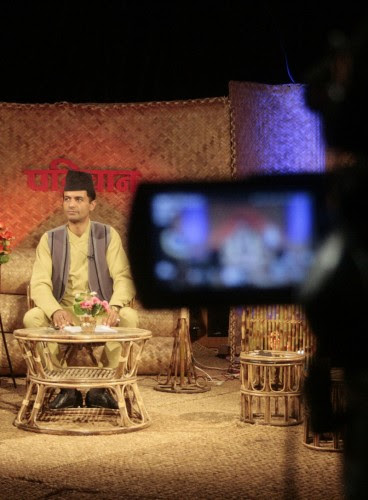
Sunil Pant hosting a TV talk show program at the Nepal TV, the largest and govt owned TV in Nepal.
I must say that I was satisfied with my participation in the CA 1. I was without doubt one of the most active, and involved MPs; I never hesitated to help other CA members who were less educated or illiterate if and whenever they had questions or confusion around the “business of the CA”. I devoted myself fully to drafting a new constitution that would embrace meaningful equality for all. In the Preliminary Draft Constitution (released by the Legislature Parliament in 2014), the chapter drafted by the Fundamental Rights Committee was agreed to by all major parties. It includes provisions to ensure non-discrimination on grounds of gender and sexual orientation.
As a member of Fundamental Rights Committee, I ensured that the section on sexual identity and rights was written comprehensively. This was met with little resistance, in part because I had conducted a lot of advocacy with the same members prior to the establishment of the committee. As we were only a five-member committee, there was a lot of work which needed to be done, and I think my willingness to take on a heavy work-load also helped gain respect on the committee which helped in terms of advocating for SGM recognition. I must say that the fundamental rights committee Chair, Ms. Binda Pandey, plaid crucial role to make the draft really inclusive and human rights friendly. The language we drafted to include three genders and citizenship rights, call for equal pay, and for a provision which would allow for marriage between two people (as opposed to limiting marriage to between a man and a woman) — is very gender inclusive and has gender-neutral language.
Interestingly, we received some resistance from other minority groups — many of whom had been staunch allies up until that point — when it came to the issue of affirmative action and inclusive representation. There was some feeling that the “pie was being cut into smaller and smaller pieces” and so the inclusion of another minority group would take something away from other groups. In the end this resistance was overcome, however, as people accepted the principle that minority and disempowered groups collectively needed recognition and rights protections.
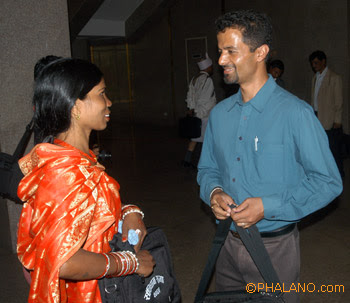
Sunil Pant talking to women constituent assembly member belonging to Scheduled Caste community
Proposed Article 6 (of the draft constitution prepared by the CA1) on citizenship ensures everyone the right to get a citizenship ID according to their gender identity. The language of the provision makes the inclusivity of this aspect unambiguous as it reads: Every citizen shall be entitled to a citizenship certificate indicating his/her mother’s or father’s ancestry as well as his/her gender identity. The chapter on Fundamental Rights, which prohibits non-discrimination, includes those vulnerable because of their sexual orientation. Article 3 (of the draft constitution prepared by the CA1) on the Right to Equality states in part (2): “There shall be no discrimination in the execution of general laws against any citizen on grounds of religion, colour of the skin, caste, ethnicity, gender, sexual orientation…or any other similar grounds.” Provided that, nothing shall prevent the state from making special legal provision for protecting, empowering or development of women, dalits, indigenous and ethnic peoples, Madhesis peasants, workers, oppressed region of the country, Muslims, backward classes, minorities, marginalized peoples, endangered communities or impoverished people, youths, children, senior citizens, sexual and gender minorities….”.
Article 3(2)’s (of the draft constitution prepared by the CA1) commitment to positive discrimination measures is reinforced by Article 3(j)(17) (of the draft constitution prepared by the CA1), which holds: “Special provisions will be made for ensuring the right of the gender and sexual minorities to lead a dignified and respectful life.” Under Article 27 (of the draft constitution prepared by the CA1), the Right to Social Justice, gender and sexual minority communities are guaranteed the right to participate in state structure and public services on the basis of the principle of proportional and inclusive representation.” Rights to health and education were specifically extended to sexual and gender minorities. Some of the articles like the Right to Marriage and Right to Family were drafted in gender-neutral language, so as to be inclusive. Notably, the agreed concept paper on Gender and Sexual Minority Community as contained in Section 2.2.2.2.27.15 of the Report of the CA-1 Fundamental Rights and Directive Principles Committee (2009), includes broad and explicit commitments to increased sensitivity and responsiveness of the State to the SGM community.
As such, while the CA 1 failed to promulgate a constitution, significant progress in both thinking about and legal recognition of the rights of sexual and gender minorities was observed between 2008 and 2012.
Second Constituent Assembly (CA2) election was held in November 2013, this time no representation was made possible from the SGM community. Now, CA2 has already passed Nepal’s New constitution, based up on the draft we left to work further as our legacy (or many say as our ‘failure’) which had proposed guarantee of sexual and gender minorities rights with many of the articles from the CA1 I mentioned above, has been finding respectable place into the actual constitution promulgated in 2015 by CA2. Thus Nepal’s constitution has become among the rarest constitutions across the world guaranteeing sexual and gender minorities rights by the constitution itself.
Thank you and Namaste!
- JK Rowling and Trans Debate is Driven by Western Perspectives - August 10, 2020
- Development crisis: Humans are the problem, Human must be the solution - September 13, 2017
- Marry a Feminine-Nature and a Masculine-Energy Before You Can Marry a Man - August 30, 2017

